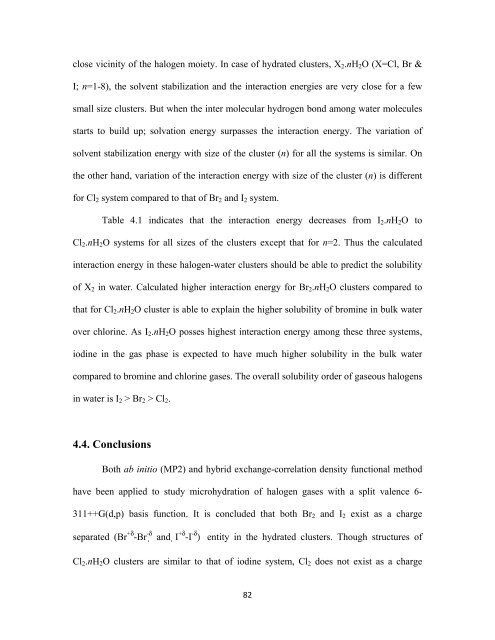CHEM01200604005 A. K. Pathak - Homi Bhabha National Institute
CHEM01200604005 A. K. Pathak - Homi Bhabha National Institute
CHEM01200604005 A. K. Pathak - Homi Bhabha National Institute
You also want an ePaper? Increase the reach of your titles
YUMPU automatically turns print PDFs into web optimized ePapers that Google loves.
close vicinity of the halogen moiety. In case of hydrated clusters, X 2 .nH 2 O (X=Cl, Br &<br />
I; n=1-8), the solvent stabilization and the interaction energies are very close for a few<br />
small size clusters. But when the inter molecular hydrogen bond among water molecules<br />
starts to build up; solvation energy surpasses the interaction energy. The variation of<br />
solvent stabilization energy with size of the cluster (n) for all the systems is similar. On<br />
the other hand, variation of the interaction energy with size of the cluster (n) is different<br />
for Cl 2 system compared to that of Br 2 and I 2 system.<br />
Table 4.1 indicates that the interaction energy decreases from I 2 .nH 2 O to<br />
Cl 2 .nH 2 O systems for all sizes of the clusters except that for n=2. Thus the calculated<br />
interaction energy in these halogen-water clusters should be able to predict the solubility<br />
of X 2 in water. Calculated higher interaction energy for Br 2 .nH 2 O clusters compared to<br />
that for Cl 2 .nH 2 O cluster is able to explain the higher solubility of bromine in bulk water<br />
over chlorine. As I 2 .nH 2 O posses highest interaction energy among these three systems,<br />
iodine in the gas phase is expected to have much higher solubility in the bulk water<br />
compared to bromine and chlorine gases. The overall solubility order of gaseous halogens<br />
in water is I 2 > Br 2 > Cl 2 .<br />
4.4. Conclusions<br />
Both ab initio (MP2) and hybrid exchange-correlation density functional method<br />
have been applied to study microhydration of halogen gases with a split valence 6-<br />
311++G(d,p) basis function. It is concluded that both Br 2 and I 2 exist as a charge<br />
separated (Br +d -Br -d and I +d -I -d ) entity in the hydrated clusters. Though structures of<br />
Cl 2 .nH 2 O clusters are similar to that of iodine system, Cl 2 does not exist as a charge<br />
82
















